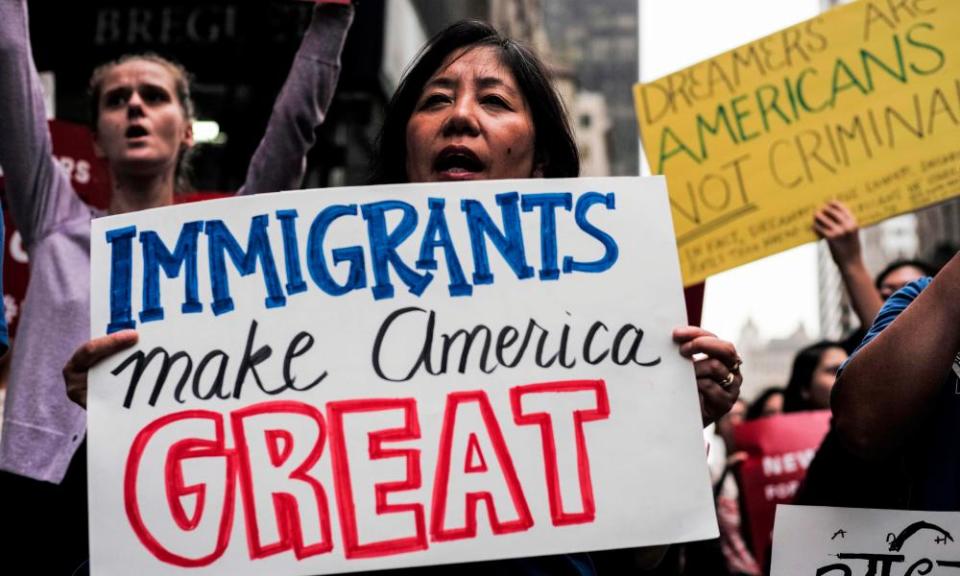Daca: Trump says Senators' bipartisan plan is 'a big step backwards'
The president insists that the deal is not sufficient, and demanded ‘a merit based system of immigration’ and funding for a border wall with Mexico

Donald Trump cast doubt on Friday that he and Congress would soon reach a deal to protect 800,000 young undocumented immigrants from deportation, saying that a bipartisan plan presented to the White House was “a big step backwards”.
On Thursday, a group of Republican and Democratic senators took a bipartisan plan to the president, raising those hopes that he would agree to continue Deferred Action for Childhood Arrivals (Daca), a program started by Barack Obama. A day earlier, a federal judge had blocked the president’s attempt to end the program outright this March.
Who are the Dreamers?
Dreamers are young immigrants who would qualify for the Deferred Action for Childhood Arrival (Daca) program, enacted under Barack Obama in 2012. Most people in the program entered the US as children and have lived in the US for years “undocumented”. Daca gave them temporary protection from deportation and work permits. Daca was only available to people younger than 31 on 15 June 2012, who arrived in the US before turning 16 and lived there continuously since June 2007. Most Dreamers are from Mexico, El Salvador, Guatemala and Honduras and the largest numbers live in California, Texas, Florida and New York. Donald Trump cancelled the program in September but has also said repeatedly he wants Congress to develop a program to “help” the population.
What will happen to the Dreamers?
Under the Trump administration, new applications under Daca will no longer be accepted. For those currently in the program, their legal status and other Daca-related permits (such as to work and attend college) will begin expiring in March 2018 – unless Congress passes legislation allowing a new channel for temporary or permanent legal immigration status – and Dreamers will all lose their status by March 2020.
Technically, as their statuses lapse they could be deported and sent back to countries many have no familiarity with. It is still unclear whether this would happen. Fear had been rising in the run-up to last week’s announcement. Those with work permits expiring between 5 September 2017 and 5 March 2018 will be allowed to apply for renewal by 5 October.
What does this week's ruling by Judge William Alsup mean?
In his ruling, Alsup ordered the Trump administration to restart the program, allowing Daca recipients who already qualify for the program to submit applications for renewal.
However, he said the federal government did not have to process new applications from people who had not previously received protection under the program.
When the Trump administration ended the Daca program, it allowed Daca recipients whose legal status expired on or before 5 March to renew their legal status. Roughly 22,000 recipients failed to successfully renew their legal status for various reasons.
Legal experts and immigration advocates are advising Daca recipients not to file for renewal until the administration provides more information about how it intends to comply with the ruling.
“These next days and weeks are going to create a lot of confusion on the legal front,” said Marielena Hincapie, executive director of the National Immigration Law Center, which has filed a separate lawsuit against the Trump administration’s termination of Daca.
But on Friday morning Trump demanded funding for a border wall with Mexico, an end to so-called “chain migration” of family-sponsored visas and an end to any lottery system of entry.
“The so-called bipartisan Daca deal presented yesterday to myself and a group of Republican Senators and Congressmen was a big step backwards,” he tweeted on Friday. “Wall was not properly funded, chain [and] lottery were made worse.”
He added, without evidence, that such measures would mean “USA would be forced to take large numbers of people from high crime countries which are doing badly”, a remark that echoed his first campaign claims deriding people from Mexico.
The potential deal was orchestrated by six senators, including three Republicans – Lindsey Graham, Jeff Flake and Cory Gardner – and three Democrats – Dick Durbin, Michael Bennet and Bob Menendez. In a statement released Thursday, the senators said that they have been working for four months to address the president’s concerns, and that they “reached an agreement in principle”.
Flake said Thursday that border barriers do not need to be a physical wall, but rather “more of a fence” with surveillance, guards and technological security.
Also on Thursday, White House spokeswoman Sarah Sanders said that although there was no final deal, “we still think we can get there”.
But the president insisted on Friday that the terms he saw were not sufficient. He said he wants “a merit based system of immigration and people who will help take our country to the next level. I want safety and security for our people. I want to stop the massive inflow of drugs”.
He then blamed Democrats for threatening a government shutdown over the budget and immigration talks. The White House recently requested $18bn in funding for a border wall, but Democrats have strongly opposed paying for a brick-and-mortar border wall that would add to the 653 miles of border barriers that already exist.
He also denied calling several countries in Central America and Africa “shitholes”, as several newspapers reported late Thursday, and which for over 12 hours the White House did not deny.

